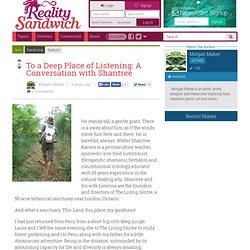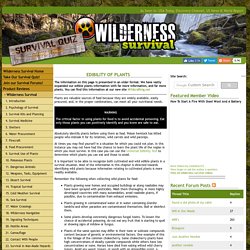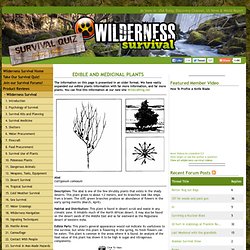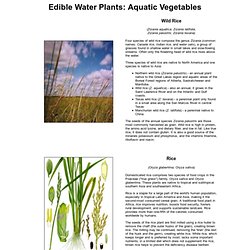

Plants For A Future : 7000 Edible, Medicinal & Useful Plants. To a Deep Place of Listening: A Conversation with Shantree. He stands tall, a gentle giant.

There is a sway about him, as if the winds move him here and there. He is barefoot, always. Walter Shantree Kacera is a permaculture teacher, ayurvedic live-food nutritionist, therapeutic shamanic herbalist, and constitutional iridology educator with 35 years experience in the natural healing arts. Shantree and his wife Lorenna are the founders and directors of The Living Centre, a 50-acre botanical sanctuary near London, Ontario. And what a sanctuary. I had just returned from Peru, from a short trip into deep jungle. When I arrived for the evenings Herb Walk there were maybe half a dozen people moving around, like bees, attending to this or that garden, plant or duty.
A small group gathered, we greeted each other and set out toward the forest.
Edibility of Plants. The information on this page is presented in an older format.

We have vastly expanded our edible plants information with far more information, and far more plants. You can find this information at our new site Wildcrafting.net Plants are valuable sources of food because they are widely available, easily procured, and, in the proper combinations, can meet all your nutritional needs. Absolutely identify plants before using them as food. Poison hemlock has killed people who mistook it for its relatives, wild carrots and wild parsnips. At times you may find yourself in a situation for which you could not plan. It is important to be able to recognize both cultivated and wild edible plants in a survival situation. Remember the following when collecting wild plants for food: Plants growing near homes and occupied buildings or along roadsides may have been sprayed with pesticides.
Plant Identification The basic leaf margins (Figure 9-1) are toothed, lobed, and toothless or smooth. Edible & Medicinal Plants. The information on this page is presented in an older format.

We have vastly expanded our edible plants information with far more information, and far more plants. You can find this information at our new site Wildcrafting.net Abal Calligonum comosum Description: The abal is one of the few shrubby plants that exists in the shady deserts. This plant grows to about 1.2 meters, and its branches look like wisps from a broom. Habitat and Distribution: This plant is found in desert scrub and waste in any climatic zone.
Edible Parts: This plant's general appearance would not indicate its usefulness to the survivor, but while this plant is flowering in the spring, its fresh flowers can be eaten. Acacia Acacia farnesiana. Common Non-Edible Plants.
Foraging The Wild. Eat The Weeds by Green Deane, the most watched forager in the world. Eat Wild: Free-Range Food & Facts. Wild Greens. Wild Root Vegetables. Foraging From Trees. Edible Flowers & Their Recipes. Edible Water Plants: Aquatic Vegetables. Water Spinach Ipomoea aquatica Ipomoea aquatica is a semi-aquatic tropical plant grown as a leaf vegetable.

Its precise natural distribution is unknown due to extensive cultivation, with the species found throughout the tropical and subtropical regions of the world. Common names include water spinach, swamp cabbage, water convolvulus, water morning-glory, kangkung, kangkong, eng chai, tangkong, kang kung, rau muống, kongxincai, home sum choy, and ong choy or tung choi. Ipomoea aquatica grows in water or on moist soil. It is most commonly grown in East and Southeast Asia.
It has also been introduced to the U.S., where its high growth rate caused it to become an environmental problem, especially in Florida and Texas.
Foraging By Location. Wild Food Recipes. Storing Wild Plants - Foraging. Wild Foods For Survival. Foraging Media, Guided Treks. 52 Plants In The Wild You Can Eat. (Before It's News) (Read: Fully Charge an iPhone in the Sun in Less Than 2 Hours) Suntactics.com April 15, 2013 We all know our vegetables and fruits are safe to eat, but what about other wild edibles?

Here are a few common North American goodies that are safe to eat if you find yourself stuck in the wild: Blackberries: Many wild berries are not safe to eat, it’s best to stay away from them. Dandelions: The easiest to recognize is the dandelion, in the spring they show their bright yellow buds. Asparagus: The vegetable that makes your pee smell funny grows in the wild in most of Europe and parts of North Africa, West Asia, and North America. Elderberries: An elderberry shrub can grow easily grow about 10 feet and yield tons of food, their leaf structure is usually 7 main leaves on a long stretched out stem, the leaves are long and round and the leaves themselves have jagged edges. Gooseberries: Mulberries: Mulberry leaves have two types, one spade shape and a 5 fingered leaf.